The color red has a special connotation in the domain of birds.
Numerous species employ the red sections of their beaks as well as feathers to ward off competitors, lure partners, and even affect sexual selection, as this tone indicates higher individual quality.
Because red is the color of fire and blood, it is commonly perceived as a hue of life and vigor.
The lovely birds are decked out in their opulent fiery attire, which gives them a magnificent and royal appearance.
The color red is associated with love, passion, and commitment. As a result, a red bird symbolizes the same thing.
List of 25 birds with red heads: –
- Acorn Woodpecker (2%)
- Anna’s Hummingbird (5.8%)
- Barn Swallow (11.1%)
- Cassin’s Finch (0.5%)
- Common Redpoll (0.5%)
- Downy Woodpecker (23.6%)
- Hairy Woodpecker (8%)
- House Finch (23.8%)
- Northern Cardinal (35%)
- Palm Warbler (3.5%)
- Pileated Woodpecker (6.3%)
- Pine Grosbeak (0.2%)
- Purple Finch (2.9%)
- Pyrrhuloxia (0.4%)
- Red Crossbill (0.6%)
- Red-bellied Woodpecker (21.2%)
- Red-breasted Sapsucker (0.5%)
- Redhead (1.9%)
- Red-headed Woodpecker (2%)
- Ruby-throated Hummingbird (5.4%)
- Scarlet Tanager (2.3%)
- Summer Tanager (1.7%)
- Vermilion Flycatcher (0.7%)
- Western Tanager (1.5%)
- Yellow-bellied Sapsucker (3%)
- Crimson Sunbird
These are the most common red-headed birds, as well as others with red on their heads or throats.
The top 25 birds with a red head were determined by cross-referencing 500 birds with red anywhere on their heads with all 1000 species of birds sighted in North America. The percentages represent the number of times these birds were recorded in ebird.org checklists.
This article includes photographs and identification information to assist you in identifying these red-headed birds.
1 . Acorn Woodpecker
A clown-faced western woodpecker that lives in small colonies and has a sophisticated social organization. The birds are most known for hoarding acorns: they drill small holes in a dead snag, then pick acorns in the fall and store them in these holes for winter consumption. A “granary tree” of this type can be utilized for generations and can have up to 50,000 holes. Incubating the eggs and feeding the young in a single nest is a communal effort, with numerous adults (up to 12 or more) participating.
If you take a short stroll through open oak or pine-oak woodlands in their area, you should be able to find Acorn Woodpeckers very easily. Look for Acorn Woodpeckers perched atop bare treetops and listen for their loud, parrot-like squawks. Observe the pattern of three black-and-white flashes in flight—one on each wing, plus the white rump. Keep an eye out for trees that are riddled with acorn-filled holes all the way up the trunk and major branches as you walk. The principal food storage “pantry” constructed and used by community groups of these intriguing woodpeckers is the granary tree.
2. Anna’s Hummingbird
Anna’s Hummingbirds are one of the most abundant hummingbirds along the Pacific Coast, yet they don’t look like your average hummingbird. They look more like flying jewellery than birds, with their iridescent green feathers and glittering rose-pink necks. Anna’s Hummingbirds are no bigger than a ping-pong ball and no heavier than a nickel, but they make a big impression. Males fly up to 130 feet in the air during their spectacular courtship rituals, then swoop down with a strange burst of noise produced by their tail feathers.
3. Barn Swallow
This swallow is among our most common birds in rural areas and semi-open land, skimming low over fields with a fluid, beautiful flight. It appears to have accepted humans as neighbors, building its nest in barns or garages, or under bridges or wharves; indeed, finding a Barn Swallow nest in an unmanmade location is becoming increasingly rare. The species can be found throughout Europe and Asia, as well as in southern Africa and South America during the winter.
Farms, fields, marshes, and lakes are examples of open or semi-open land. It can be found in any open or partially open area, especially near water, with the exception of very dry land and continuous woodland. Breeds frequently around farms, buildings, and towns, and forages in fields or ponds.
4. Cassin’s Finch
Cassin’s Finch, like a somewhat larger, longer-billed form of the Purple Finch, lives in the West’s mountains and conifer forests. It can be found at very high elevations, especially in late summer, in the scrubby woodland just below tree line. At other seasons, roving flocks of birds fly through the woods, frequently feasting on buds and seeds high in the trees. The male’s intricate song frequently includes brief imitations of other species.
They are not as prevalent in backyards as House or Purple Finches, but they may be attracted by sunflower seed feeders, especially in the winter, or fruiting bushes including cotoneaster, mulberries, firethorn, grape, and apple.
5. Common Redpoll
Among the ‘winter finches,’ which nest in the Arctic and occasionally invades southern Canada as well as the northern states. Redpolls are small, active birds that feed vigorously on seeds amid trees and weeds, flitting and climbing acrobatically in flocks that appear to be constantly on the move. They have a remarkable ability to tolerate freezing temperatures for their small size; their southerly travels are triggered by a short scarcity of food in the North, not by cold. Redpolls are frequently surprisingly tame at bird feeders in the winter. Mostly in winter, they would sometimes burrow into the snow to keep warm. They may consume up to 42% of their body weight per day and store up to 2 grams of seeds in a flexible park of their esophagus.
Can Peacocks Fly? Interesting Facts with Pictures
6. Downy Woodpecker
A little woodpecker that is found over much of North America. The black-and-white plumage is almost identical to that of the bigger Hairy Woodpecker. Concentrate on the bill: Downy’s beak is substantially shorter than the length of his skull. Take notice of the little black marks on the white outer tail feathers as well. Pacific birds have smaller white patches on their wings and a grayer body than Eastern birds. This species can be found in any woodland habitat, while western birds are mainly limited to riparian habitats. Forages more frequently on smaller branches than the Hairy Woodpecker. A frequent visitor to backyard feeders, particularly fond of suet. Calls include a quiet “pik!” and a descending rattle that is weaker than that of the Hairy Woodpecker.
7. Hairy Woodpecker
A medium-sized woodpecker that is ubiquitous and widespread in North America as far south as western Panama. The black-and-white plumage is remarkably comparable to that of the tiny Downy Woodpecker. Pay attention to the bill: Hairy has a longer bill, about the length of his head. Also look for crisp white outer tail feathers. There is some color variation across the range; birds in western North America and, especially, Central America are brownish, with some white on the wings. Occurs in wooded areas with huge trees. A frequent visitor to backyard feeders, especially fond of suet. Calls include a loud “peek!” and a rapid rattle that is louder than that of the Downy Woodpecker.
8. House Finch
Photo by Joshua J. Cotten on Unsplash
It is common in suburban areas across North America, as well as open woods, brushy field borders, and deserts. Males have different colours and intensities of red. Some males are yellow or orange in color. Females are dull gray-brown with simple features and fuzzy stripes on their underparts. House Finch males are more orangey-red than Purple and Cassin’s Finch, with color equally strong on crown, throat, and breast. The red color is primarily limited to the head and upper chest, with a cool gray-brown nape, back, and wings. Pale sides with noticeable brown streaks and a lack of red tones. Females have a more diffuse patterning overall and a less prominent face pattern. Frequently sings loudly in the neighborhood and visits feeders.
9. Northern Cardinal
Photo by Joshua J. Cotten on Unsplash
The Cardinal, one of our most famous birds, is the official state bird of seven eastern states. Its range has been expanding northward for decades, and it now delights winter days with its color and whistled song as far north as southeastern Canada. Sunflower seed-filled feeders may have facilitated its northward growth. The Cardinal is mainly absent west of the Great Plains, but it is plentiful in the desert Southwest.
10. Palm Warbler
Palm Warblers are primarily brown color birds having yellow under tail coverts. Their tails have little white edges that are visible in flight. The undersides of eastern birds are bright yellow with rufous streaks on their breasts, while western birds are faintly streaked and drabber in hue. They have a dark line running between each of their eyes. Adults have rufous crowns and yellow throats in breeding plumage.
Palm Warblers nest on the outskirts of boreal woodland bogs. When sighted in Washington during migratory, they are mainly found in hedgerows, thickets, and other edge habitats along the coast, frequently frequenting thickets of non-native Scots broom.
11. Pileated Woodpecker
The largest woodpecker in North America, a huge, darting bird with a blazing crest (except the Ivory-bill, which is almost certainly extinct). Pileated leaves typical rectangular holes in dead trees, excavating deep through rotted wood to reach carpenter ant nests. This species became rare in eastern North America due to forest clearing centuries ago, but has progressively increased in numbers since the early twentieth century. It can also be found in parks and woodlots on the outskirts of major cities, where it goes unnoticed.
12. Pine Grosbeaks
Pine Grosbeaks are a finch species with red heads, breasts, and backs and grey on the rest of their body and wings. They are huge for finches and move quickly.
They can be found in regions of the West during the summer in open spruce and pine forests, or in northern states during the winter. Pine Grosbeaks might be attracted to black oil sunflower seed feeders in the northern states throughout the winter.
13. Purple Finch
The male Purple Finch is more of an old-rose tint than purple. This species is prevalent in the north and east, as well as along the Pacific coast, but it is quite rare in the Rocky Mountains. Purple Finches forage in open forests, both in trees and on the ground. They readily frequent bird feeders, but their numbers have declined in the Northeast, where competition from introduced House Sparrows and eventually House Finches may have driven them back into the woods.
14. Pyrrhuloxia
This ‘desert cardinal’ is common in the Southwest’s parched region. Its singing and habits are similar to that of the Northern Cardinal, and the two can be found in many desert locations. The Pyrrhuloxia, on the other hand, can endure drier and more open settings; it is less stationary and more gregarious than southwestern Cardinals, with flocks frequently moving away from breeding locations in winter. The unusual word ‘Pyrrhuloxia,’ which was once part of this bird’s scientific name, combines the Latin term for the Bullfinch with a Greek allusion to the shape of the bird’s bill.
Types of Hummingbirds in New Jersey
15. Red Crossbill
The hard kip-kip calottes of these stubby little nomads as they fly overhead in evergreen woodlands are often the first to be recognised. Red Crossbills in North America range from small-billed birds that eat spruce cones to large-billed birds that eat pine cones. Scientists have long debated how to categories these many kinds. According to new research, there could be up to eight different entire species of Red Crossbills on this continent. Slight differences in calottes appear to be sufficient to prevent them from mixing, and multiple types can coexist in the same area without interbreeding.
16. Red-bellied Woodpecker
Red-bellied Woodpeckers have a delicate red belly which makes them hard to identify. This red-headed bird has a black-and-white striped back as well as a red head and nape.
They are found in the Eastern United States. In the spring and summer, they have a loud call and can be found in woods and forests, particularly around deadwood. They are a migratory woodpecker.
Suet feeders will attract more Red-bellied Woodpeckers, and they will occasionally feed on hummingbird feeders.
17. Red-breasted Sapsucker
Medium-sized woodpecker from far western North America with a striking appearance. Beautiful plumage, predominantly red on the head and breast, with a dramatic white stripe on the shoulder. Some have a hazy black-and-white pattern on their heads, although they always have more red than Red-naped Sapsucker. There is also modest white mottling on the back and no black on the breast. Juveniles have a dark brown head and breast. Beware of hybrids with Red-naped, which may be best left unlabeled. Breeds in coniferous and mixed forests, falling to lower elevations in winter and reaching as far south as northern Baja in the winter. Drills rows of sap wells into tree bark like other sapsuckers. Listen for uneven drumming (similar to morse code) and a variety of nasal noises.
18. Redhead
The Redhead duck does indeed have a grey body with a reddish-brown head, black breast and tail, and a reddish-brown head.
They can be found in all states, especially during the winter, when they can be found in flocks of thousands, particularly around the Gulf Coast.
They can be found nesting in reedy ponds in the Great Plains and West during the summer.
19. Red-headed Woodpecker
This distinctive bird was a favourite of early ornithologists such as Alexander Wilson and John James Audubon. It prefers to exist in tiny colonies and is often noticeable because to its strong pattern, sharp calls, and active behaviour in semi-open area. Although it only migrates short distances, small groups of migrants may be seen in early fall and late spring. The Red-headed Woodpecker, once a common bird in eastern North America, is now uncommon and local in many areas.
20. Ruby-throated Hummingbird
There are hundreds of hummingbird species in the American tropics, and more than a dozen in the western United States, but only the Ruby-throated Hummingbird nests east of the Great Plains. In the summer, it is rather widespread in open woodlands and gardens. It beats its wings more than 50 times per second while hovering in front of a bloom to sip nectar. Despite their diminutive size, some Ruby-throats may migrate from Canada to Costa Rica.
21. Scarlet Tanager
Breeding males are easily identified: bright red with black wings and tail. Females and nonbreeding males have dull yellow-olive bodies and dark wings (blacker on males, grayer on females). Female Summer Tanagers have a larger bill and less contrast between wing and body color. Breeds in mature deciduous forests, preferring to stay high in the canopy. Migrants are often seen in mature woods. Northern South American winters. Visits feeders on occasion in the spring, especially after spells of rain or cold weather. Look for burry singing, which sounds like an American Robin with a sore throat.
22. Vermilion Flycatcher
Many flycatchers are dull, but the male Vermilion Flycatcher stands out. It is generally seen perched low in open areas near water, slowly dipping its tail like a phoebe. As if the male’s vivid colours weren’t enough of an advertisement, he additionally puffs up his feathers and flutters high in the air while singing incessantly. The Vermilion Flycatcher, which is rather common in portions of the southwest, is also prevalent in Central and South America.
Owl Legs- All You Need To Know With Pictures
23. Western Tanager
Males for breeding are a magnificent brilliant yellow with a black back and a red head. Females and young males have a duller appearance, sometimes predominantly greyish with a hint of yellow on the cheeks and undertail coverts. Always look for the two white wingbars and the light bill. Breeds primarily in coniferous or mixed forests at moderate to high elevations. It can be found as far south as Central America during the winter, where it can be found in any woodland habitat. Stays high in the canopy most of the time. Listen for the male’s burry song in the spring and summer, as well as a short, rising rattle all year.
24. Yellow-bellied Sapsucker
In most of its range, the sapsucker is striking and recognizable; it is the only sapsucker in eastern North America. It can be distinguished from Downy and Hairy Woodpeckers by its long, solid white wing patch. Adult males have a red crown and neck; females have a white throat; and juveniles are a jumbled brownish-gray throughout. The eponymous yellow belly can be difficult to spot and is sometimes completely absent. Looks untidy a lot of the time, especially in the fall and winter. In comparison, the Red-naped Sapsucker’s distribution scarcely overlaps with that of the Red-napped Sapsucker. Male Yellow-bellied has a complete black border around the red neck patch, and the white patterns on the back are more extensive and haphazard. It can be found in practically any woodland area, nesting in Canada’s boreal forest and wintering as far south as Costa Rica. Drills rows of sap wells into tree bark like other sapsuckers. Listen for uneven drumming (similar to morse code) and a variety of nasal noises.
25. Summer Tanager
Summer Tanager males are bright red all over, with the females being yellow. They breed in southern and eastern states before heading to Central and South America for winter.
Adults have stout pointed bills and measure 17 cm (6.7 in) in length and 29 g (1.0 oz) in weight. Wingspan ranges from 28 to 30 cm.[11] Adult males are rose red and similar in appearance to the hepatic tanager, although the latter has a dark bill; females are orangish on the underparts and olive on top, with olive-brown wings and tail. As with all other birds, all red and orange colorations are acquired through their diet.
26. Crimson Sunbird
Crimson sunbirds are tiny, only 11 cm long. They have medium-length thin down-curved bills and brush-tipped tubular tongues, both adaptations to their nectar feeding. The adult male has a crimson breast and maroon back. The rump is yellow and the belly is olive. The female has an olive-green back, yellowish breast and white tips to the outer tail feathers.
Male is bright red with a dark gray belly and iridescent blue cap and “moustache.” Female is dull olive-yellow overall with brighter underparts. High, squeaky repetitive song is loud but often difficult to locate in high branches. Calls frequently, giving various squeaks and “tsip” notes while foraging.
Conclusion
As you’ve seen, there are several birds having red heads, however this list may enable you to identify any red-headed birds you see.
Read Also
Mandarin Duck – Facts, Diet, Spotting tips & Pictures


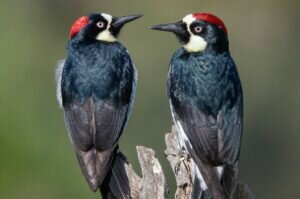

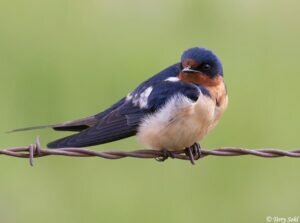
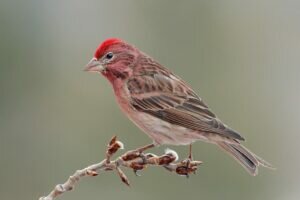
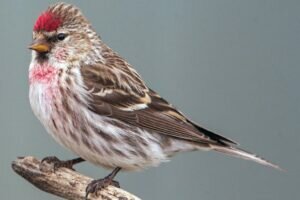
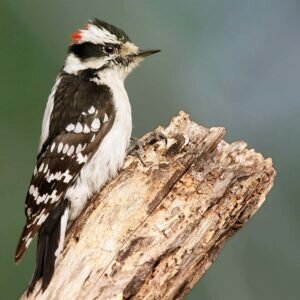
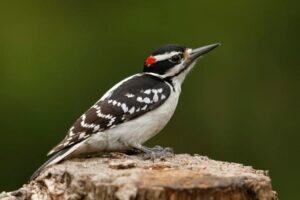



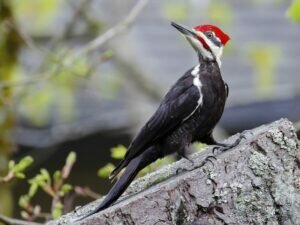
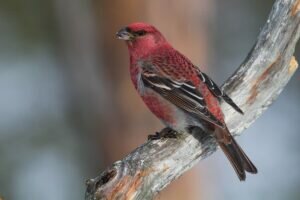
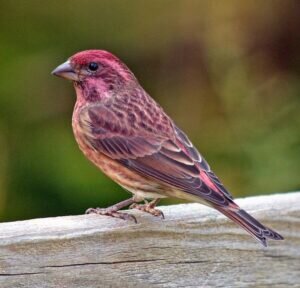


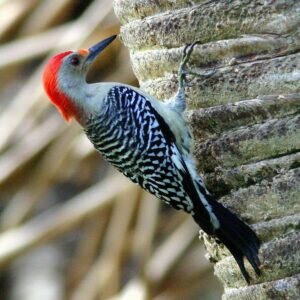
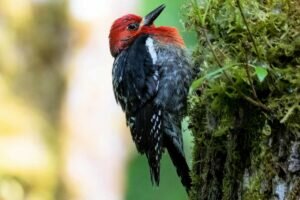
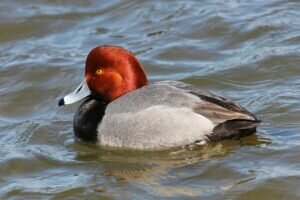


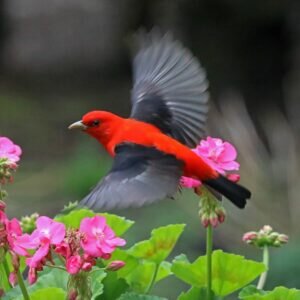
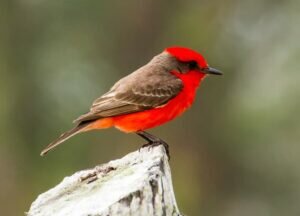


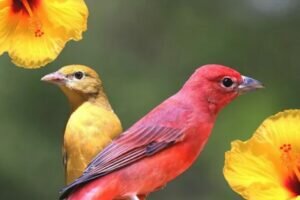
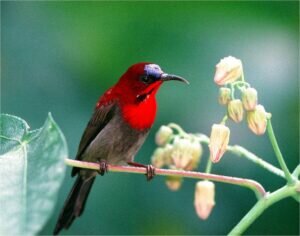
5 thoughts on “26 Beautiful Birds with Red Heads – Identification with Photos”